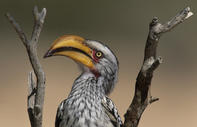
All species of hornbills, excluding the ground hornbill, share an intriguing nesting method. They are monogamous, with a pair bond normally lasting only a single season. When a pair bond, the male will courtship feed the female with either solid items or regurgitation.
The female voluntarily “jails” herself in a tree cavity when nesting. The pair will seal up the entrance to a narrow hole with material brought by the male hornbill. The material consists of mud and plant material, that is then mixed with faeces. Due to this process, the female is the only one to incubate the eggs.
The female is fed by the male during the incubation. The female undergoes a very rapid moult of her tail and flight feathers, when sealed in the nest. The male undertakes a normal slow moult, retaining the ability to supply the female with food.
 The African grey hornbill is a medium-sized bird, but one of the smaller hornbills at 46 cm in length....
The African grey hornbill is a medium-sized bird, but one of the smaller hornbills at 46 cm in length.... Ground hornbills are conspicuous by their size and their striking black plumage and red wattles....
Ground hornbills are conspicuous by their size and their striking black plumage and red wattles.... Hornbills, specifically yellow-billed, red-billed and grey, have a remarkable nesting strategy....
Hornbills, specifically yellow-billed, red-billed and grey, have a remarkable nesting strategy.... This hornbill has grey upperparts and mostly white underparts. A black strip runs down the back of the neck....
This hornbill has grey upperparts and mostly white underparts. A black strip runs down the back of the neck.... The yellow-billed hornbill is a medium sized bird, at 50 cm in length. This hornbill has grey upperparts and mostly white underparts....
The yellow-billed hornbill is a medium sized bird, at 50 cm in length. This hornbill has grey upperparts and mostly white underparts.... The trumpeter hornbill is a medium sized bird, at 58 cm in length. This hornbill has an all black back and a white belly and underwing cover...
The trumpeter hornbill is a medium sized bird, at 58 cm in length. This hornbill has an all black back and a white belly and underwing cover...